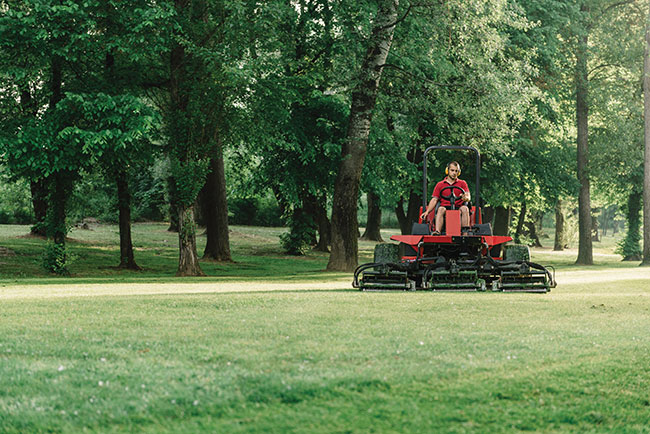
Features
Golf
Golf’s growing pains must be addressed in the aftermath of COVID, says USGA official
Need for renovations and concerns over labour shortages and water issues mustn’t fall behind game’s growth
September 15, 2023 By Mike Jiggens
 Labour shortages on golf courses have presented a problem in recent years despite golf’s growth launched during COVID.
Photo credit: Microgen/Adobe Photo
Labour shortages on golf courses have presented a problem in recent years despite golf’s growth launched during COVID.
Photo credit: Microgen/Adobe Photo The game of golf has had a lot going for it the past few years, since the COVID-19 pandemic was declared. The number of rounds has increased, more golfers have migrated to the game, including more women and juniors, and course renovations are on the rise.
“All of that is a really big opportunity for the game,” says George Waters, senior manager of the USGA Green Section education program.
He points out, however, that despite the newfound interest in the game, golfer satisfaction is “frustratingly low.”
Waters was among the featured speakers at February’s Ontario Turfgrass Symposium, held at the University of Guelph.
“What are people finding when they come to the game? When they come to play, are they finding something that’s worth their time and money and something they want to keep doing?”
Waters, whose background is in golf course design, maintenance and construction, having been involved in renovation and restoration projects at such venues as Pinehurst No. 2, the California Golf Club and various courses in Canada, says golf’s success can also be problematic. For example, most golf courses have become so busy that they’ve contributed to a slower pace of play which “drives golfers crazy” in terms of their enjoyment of a round of golf, he says.
The USGA conducted golfer satisfaction research a couple of years ago and found that the experience of playing a round of golf was often on par with dealing with the federal government and airlines.
“This is something to be concerned about,” Waters says.
From the perspective of the golf course, issues such as labour shortages and water restrictions have become more common and have become a factor in golfer satisfaction, he adds.
“Expectations are not always in great alignment with the resources and reality that different golf courses are working within.”
The labour shortage issue is one that golf courses are experiencing worldwide. Many clubs have increased their pay scale for maintenance workers but are still having difficulty finding those who want to work.
Waters says golf courses contemplating renovation work must consider such matters as labour and water availability, noting labour was once plentiful and wages were cheaper.
“All of a sudden, golf course features that were really cool and were integral parts of the course can be really hard to maintain if you don’t have the staff available to maintain them. You’ve got to change your maintenance practices, you’ve got to make a lot of adjustments, and the expectation part of that plays a big role. Expectations can be slower to adjust to than the reality of a golf course labour situation, and that can lead to unhappy customers.”
Waters says renovations present an opportunity to address satisfaction challenges as well as address sustainability issues, including both financial and environmental sustainability. He adds it’s an opportunity to put a golf course on a good path for the future as a business and as part of the landscape and environment.
“Finding balance between design, maintenance and expectations is really a key to that. It’s really not as easy as one might think. Realistic expectations and good planning are essential for success.”
Expectations of what a project delivers or what it will cost to maintain after the fact can be misaligned with the resources available, Waters says, adding something meant to be positive can become negative and problematic.
California Club’s restoration project
The goal of the California Golf Club restoration project, he says, was to return to the classic 1920s bunkering style of architect Alister MacKenzie. The club was willing to invest what was necessary to bring the bunkering back and to ensure everything would be maintained afterward. The project produced good results, including hand-edging, with the club wishing to increase its profile by breaking into the world’s top 100 rankings and bolstering its membership.
Both goals were achieved, Waters says, but there was a financial price to be paid. He warns that golf clubs can often have lofty expectations, but the resources might not be there to support them or the necessary post-care.
“That’s where the balance question comes into play.”
Putting greens are a golf course’s most important playing area and are typically the most expensive to maintain on a square footage basis. Renovation work done on greens involves improved drainage and the use of better turf varieties.
Waters asked his audience if greens renovation projects are meant to address existing problems or if their goal is to change the greens’ performance. Thinking about such things will help the decision-making process with a greater insight into the amount of money needed.
It’s important the balance component is considered from the beginning of a project through to its completion, he says, noting that green speed is an issue that can be problematic, both in terms of finances and its environmental sustainability.
“Green speeds are faster today than what the putting green contours were really designed for.”
The impact from that, he says, is a decrease in playable area which equates to a loss of its original architectural interest and a green’s ability to spread out wear and tear. A green that isn’t playing well because it’s too fast might be more maintenance-related than architectural in nature.

When renovating greens, considerations must include shade and air movement, especially when greens are regrassed and have upgraded drainage.
Photo credit: lovelyday12/Adobe Phot
Green speed expectations
Waters says that when greens are being renovated, it’s easy to forget about green speed expectations and the conditioning required once the job is complete.
“If I build a cool and crazy green, will that match what’s there on the rest of the property? And will it be unplayable for what they want to do on the maintenance side of things?”
Ways to get the most from a putting green renovation project, he says, includes selecting better, adaptive grasses that can save time and money and reduce the risk of damage, addressing growing environments and being mindful of long-term maintenance programs. More golf courses in Canada and the northern regions of the United States are switching to grasses that better adapt to colder winters and transition into spring with little to no damage.
“If you’re able to achieve some of the architectural goals and build in a little bit of ease of maintenance in the process without compromising too much, you can really set up a facility into a good space for a really long time and save a lot of money in the long run.”
When renovating greens, considerations must include shade and air movement, Waters says. Greens that are regrassed and have upgraded drainage need sunlight.
“Failing to address tree issues, you end up in the same situation.”
Golf courses are apt to be temporarily closed during renovations which, Waters says, is an ideal opportunity to thin or prune trees and strategically place fans near greens.
Green speed has become the “de facto” measuring stick for gauging putting green quality because it’s measurable when using a Stimpmeter, he says, but adds the notion that what gets measured gets managed isn’t necessarily the right train of thought.
Newer technology in the form of the GS3 ball has all but made the Stimpmeter obsolete. Sized the same as a golf ball, the “smart” GS3 ball contains an inner sensor that not only measures green speed, but surface firmness and roll trueness as well. The device provides a wider range of meters and measurables, painting a better picture about how a green is playing.
Green speed isn’t the primary concern among golf courses in Scotland and Ireland, Waters says. Instead, firmness and trueness are the greater focus. It’s his hope that the GS3 ball will allow golf courses to take a more holistic viewpoint about what is required for a good and healthy putting green.
Print this page